Taofeng Xie
Towards Globally Predictable k-Space Interpolation: A White-box Transformer Approach
Aug 06, 2025Abstract:Interpolating missing data in k-space is essential for accelerating imaging. However, existing methods, including convolutional neural network-based deep learning, primarily exploit local predictability while overlooking the inherent global dependencies in k-space. Recently, Transformers have demonstrated remarkable success in natural language processing and image analysis due to their ability to capture long-range dependencies. This inspires the use of Transformers for k-space interpolation to better exploit its global structure. However, their lack of interpretability raises concerns regarding the reliability of interpolated data. To address this limitation, we propose GPI-WT, a white-box Transformer framework based on Globally Predictable Interpolation (GPI) for k-space. Specifically, we formulate GPI from the perspective of annihilation as a novel k-space structured low-rank (SLR) model. The global annihilation filters in the SLR model are treated as learnable parameters, and the subgradients of the SLR model naturally induce a learnable attention mechanism. By unfolding the subgradient-based optimization algorithm of SLR into a cascaded network, we construct the first white-box Transformer specifically designed for accelerated MRI. Experimental results demonstrate that the proposed method significantly outperforms state-of-the-art approaches in k-space interpolation accuracy while providing superior interpretability.
Joint PET-MRI Reconstruction with Diffusion Stochastic Differential Model
Aug 07, 2024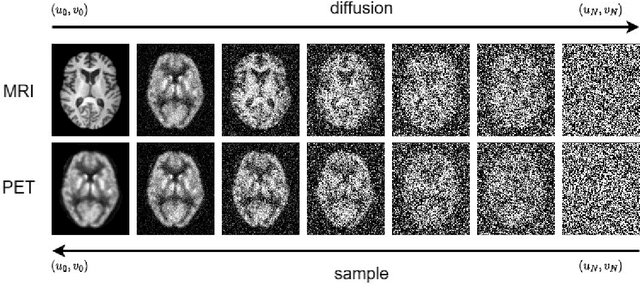
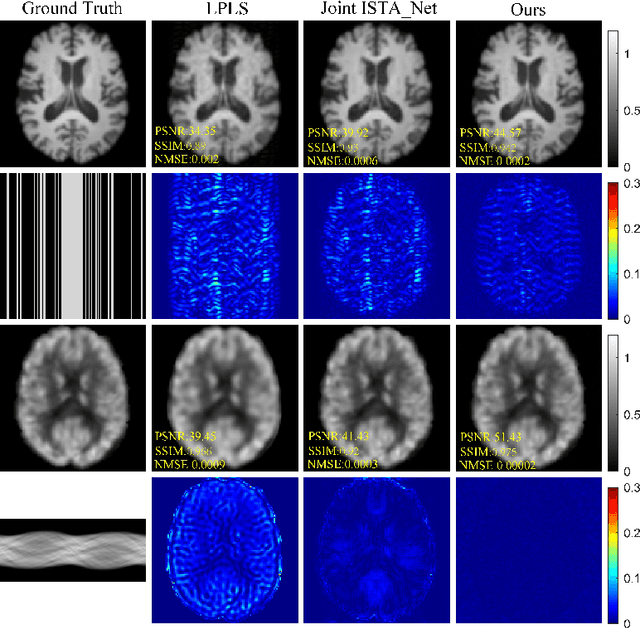
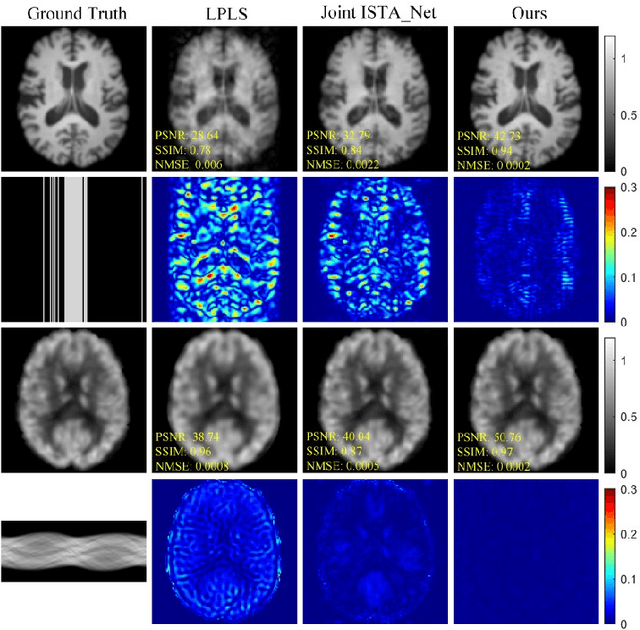
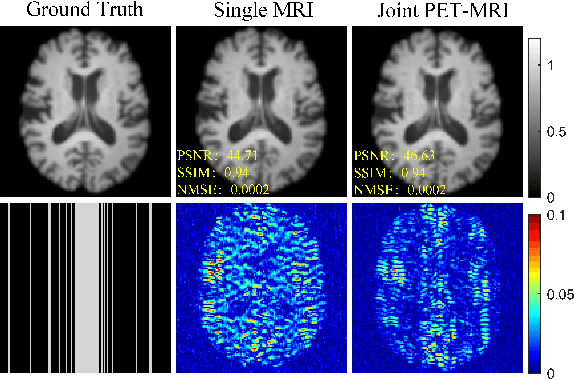
Abstract:PET suffers from a low signal-to-noise ratio. Meanwhile, the k-space data acquisition process in MRI is time-consuming by PET-MRI systems. We aim to accelerate MRI and improve PET image quality. This paper proposed a novel joint reconstruction model by diffusion stochastic differential equations based on learning the joint probability distribution of PET and MRI. Compare the results underscore the qualitative and quantitative improvements our model brings to PET and MRI reconstruction, surpassing the current state-of-the-art methodologies. Joint PET-MRI reconstruction is a challenge in the PET-MRI system. This studies focused on the relationship extends beyond edges. In this study, PET is generated from MRI by learning joint probability distribution as the relationship.
* Accepted as ISMRM 2024 Digital poster 6575. 04-09 May 2024 Singapore
Joint Diffusion: Mutual Consistency-Driven Diffusion Model for PET-MRI Co-Reconstruction
Nov 24, 2023Abstract:Positron Emission Tomography and Magnetic Resonance Imaging (PET-MRI) systems can obtain functional and anatomical scans. PET suffers from a low signal-to-noise ratio. Meanwhile, the k-space data acquisition process in MRI is time-consuming. The study aims to accelerate MRI and enhance PET image quality. Conventional approaches involve the separate reconstruction of each modality within PET-MRI systems. However, there exists complementary information among multi-modal images. The complementary information can contribute to image reconstruction. In this study, we propose a novel PET-MRI joint reconstruction model employing a mutual consistency-driven diffusion mode, namely MC-Diffusion. MC-Diffusion learns the joint probability distribution of PET and MRI for utilizing complementary information. We conducted a series of contrast experiments about LPLS, Joint ISAT-net and MC-Diffusion by the ADNI dataset. The results underscore the qualitative and quantitative improvements achieved by MC-Diffusion, surpassing the state-of-the-art method.
Matrix Completion-Informed Deep Unfolded Equilibrium Models for Self-Supervised k-Space Interpolation in MRI
Sep 24, 2023



Abstract:Recently, regularization model-driven deep learning (DL) has gained significant attention due to its ability to leverage the potent representational capabilities of DL while retaining the theoretical guarantees of regularization models. However, most of these methods are tailored for supervised learning scenarios that necessitate fully sampled labels, which can pose challenges in practical MRI applications. To tackle this challenge, we propose a self-supervised DL approach for accelerated MRI that is theoretically guaranteed and does not rely on fully sampled labels. Specifically, we achieve neural network structure regularization by exploiting the inherent structural low-rankness of the $k$-space data. Simultaneously, we constrain the network structure to resemble a nonexpansive mapping, ensuring the network's convergence to a fixed point. Thanks to this well-defined network structure, this fixed point can completely reconstruct the missing $k$-space data based on matrix completion theory, even in situations where full-sampled labels are unavailable. Experiments validate the effectiveness of our proposed method and demonstrate its superiority over existing self-supervised approaches and traditional regularization methods, achieving performance comparable to that of supervised learning methods in certain scenarios.
Convex Latent-Optimized Adversarial Regularizers for Imaging Inverse Problems
Sep 17, 2023



Abstract:Recently, data-driven techniques have demonstrated remarkable effectiveness in addressing challenges related to MR imaging inverse problems. However, these methods still exhibit certain limitations in terms of interpretability and robustness. In response, we introduce Convex Latent-Optimized Adversarial Regularizers (CLEAR), a novel and interpretable data-driven paradigm. CLEAR represents a fusion of deep learning (DL) and variational regularization. Specifically, we employ a latent optimization technique to adversarially train an input convex neural network, and its set of minima can fully represent the real data manifold. We utilize it as a convex regularizer to formulate a CLEAR-informed variational regularization model that guides the solution of the imaging inverse problem on the real data manifold. Leveraging its inherent convexity, we have established the convergence of the projected subgradient descent algorithm for the CLEAR-informed regularization model. This convergence guarantees the attainment of a unique solution to the imaging inverse problem, subject to certain assumptions. Furthermore, we have demonstrated the robustness of our CLEAR-informed model, explicitly showcasing its capacity to achieve stable reconstruction even in the presence of measurement interference. Finally, we illustrate the superiority of our approach using MRI reconstruction as an example. Our method consistently outperforms conventional data-driven techniques and traditional regularization approaches, excelling in both reconstruction quality and robustness.
Synthesizing PET images from High-field and Ultra-high-field MR images Using Joint Diffusion Attention Model
May 06, 2023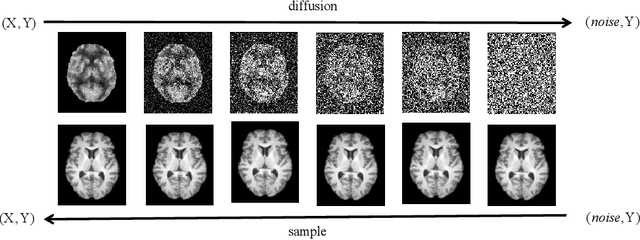
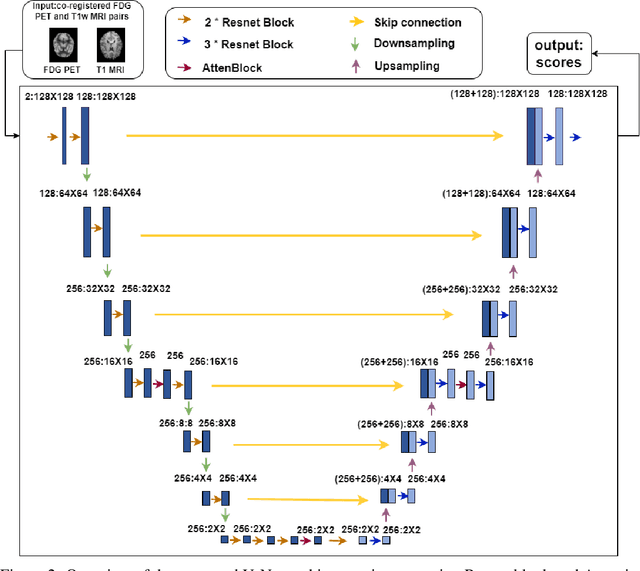
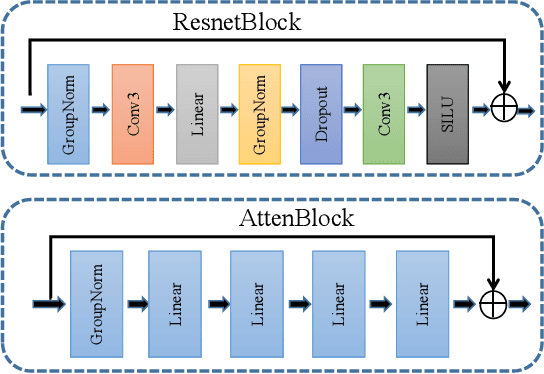
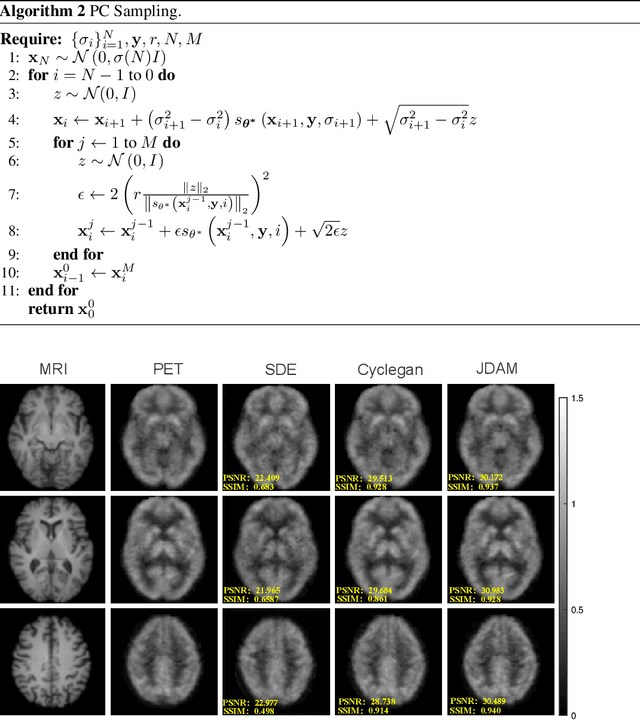
Abstract:MRI and PET are crucial diagnostic tools for brain diseases, as they provide complementary information on brain structure and function. However, PET scanning is costly and involves radioactive exposure, resulting in a lack of PET. Moreover, simultaneous PET and MRI at ultra-high-field are currently hardly infeasible. Ultra-high-field imaging has unquestionably proven valuable in both clinical and academic settings, especially in the field of cognitive neuroimaging. These motivate us to propose a method for synthetic PET from high-filed MRI and ultra-high-field MRI. From a statistical perspective, the joint probability distribution (JPD) is the most direct and fundamental means of portraying the correlation between PET and MRI. This paper proposes a novel joint diffusion attention model which has the joint probability distribution and attention strategy, named JDAM. JDAM has a diffusion process and a sampling process. The diffusion process involves the gradual diffusion of PET to Gaussian noise by adding Gaussian noise, while MRI remains fixed. JPD of MRI and noise-added PET was learned in the diffusion process. The sampling process is a predictor-corrector. PET images were generated from MRI by JPD of MRI and noise-added PET. The predictor is a reverse diffusion process and the corrector is Langevin dynamics. Experimental results on the public Alzheimer's Disease Neuroimaging Initiative (ADNI) dataset demonstrate that the proposed method outperforms state-of-the-art CycleGAN for high-field MRI (3T MRI). Finally, synthetic PET images from the ultra-high-field (5T MRI and 7T MRI) be attempted, providing a possibility for ultra-high-field PET-MRI imaging.
 Add to Chrome
Add to Chrome Add to Firefox
Add to Firefox Add to Edge
Add to Edge